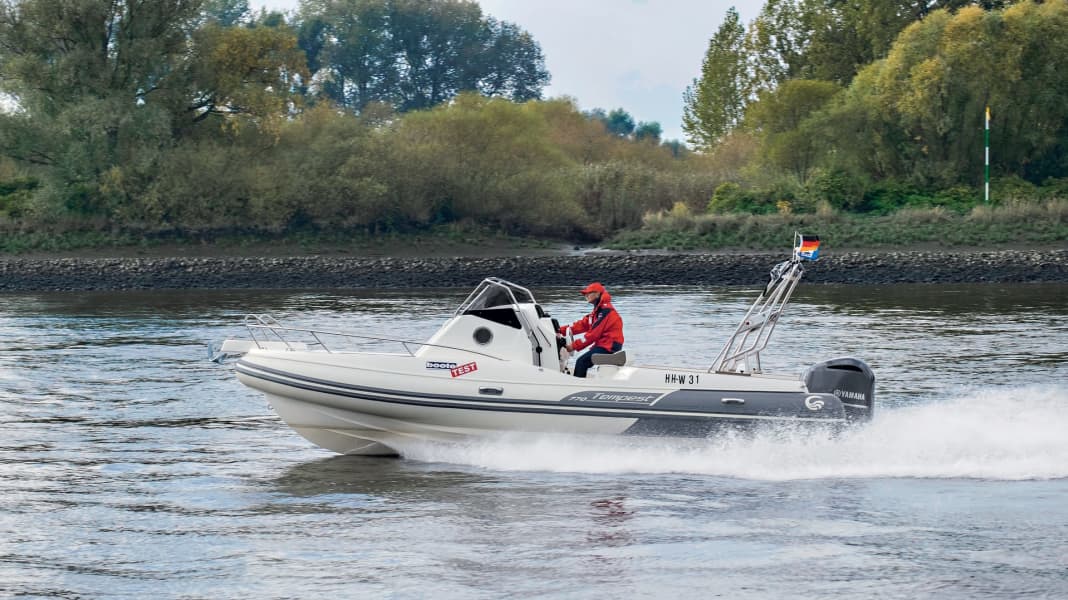
You can do what you do. And Capelli can do RIBs, from the 2.20 metre tender to the 10.07 metre long flagship, the Tempest 1100.
The Italian boat builders advertise with solid construction, top quality, a generous amount of space and a complete range of equipment. But do they actually deliver?






The heavily skimmed hull, which promises and delivers rough water comfort, and the customised support hose show no defects. The glued seams are perfect, the laminate is rounded and sealed at the interfaces. The stainless steel fittings are also in good shape.
In German: the pulpit, (folding) equipment carrier, mooring cleats, bathing ladder, handrails and anchor holder are among the plus points. The technicians impressed the tester with a solid battery box and main switch, neatly laid cables and a fuel system equipped as standard with lines made of copper pipe and fabric hose, stopcock, water separator, stainless steel tank and inspection hatch.
One point of criticism: the second hose clamps are missing from the connections. Better safe than sorry!
The attribute "generous" applies solely to the space available in the cockpit and on the foredeck, where there is room for a convertible stern bench seat, sunbed, galley console, large storage compartments, bimini top and stern shower.
In the slip cabin, on the other hand, it can get a bit cramped - especially for XL people, who certainly don't feel comfortable on the hard cushions of the V-berth and find it difficult to find space in the mini toilet room, in which there is a pump toilet.
The topic of equipment is headed "Everything that is good and expensive". If you go all out on the accessories list, which includes a galley with cooker, sink and refrigerator, bathing platform, tarpaulins, equipment carrier, waste holding tank and Flexiteak cockpit floor, you can add another 20,000 euros to the standard price. In return, they get a weekender that leaves nothing to be desired.
Lateral stability, self-draining cockpit, anti-slip structure, well-placed handrails, bathing ladder, automatic bilge pump, tank compartment blower and fire extinguisher ensure the necessary safety, Yamaha's F 250 makes driving a pleasure.
The V6 engine, equipped with four-valve technology and variable camshaft control, accelerates the 1600 kg Capelli to 42.2 knots at 5600 rpm. It is not only the speed and revs that show that the fitted steel propeller is a good choice.
Trimmed correctly, the bow stays where it belongs when transitioning to planing - on the water. The boat can be steered into tight bends and circles without hooking in, rocking or prop ventilation. We criticise the hydraulic steering, which becomes sluggish when pulling out of a fast roundabout, and the driver's seat, which is not and should not be one.
The padded lid of the galley console has no backrest and offers zero lateral support. You can only wish the driver, who is flying blind behind the heavily tinted windscreen in the dark and rain, stability. The plotter and compass show him where to go, and the digital Yamaha instruments show him how the engine is doing.
The fuel consumption display is high up on the popularity scale. If you exercise restraint with the constantly smooth gear/throttle lever, you can plan on a remarkable range of 162 nm at an economical gliding speed (a good 20 knots). Plus reserve, of course.
However, the "whispering giant" only feels really comfortable at 35 knots. At 92 dB(A), it works loudly, but without being annoying. What was that again? The sound makes the music. The Yamaha only plays heavy metal, i.e. 96 dB(A) and 2.23 l/sm, at full throttle.
During the slow waltz in displacement mode, low wave impact and course stability set the pace. This leaves the manoeuvring characteristics, which are characterised by small turning circles, direct steering and propeller ventilation in reverse.
Conclusion:
If you invest in additional accessories, the Capelli 770 WA is a fully equipped, first-class RIB with sporty but safe handling characteristics. The only thing that takes some getting used to
The only thing that takes some getting used to is the standing area for the driver.

